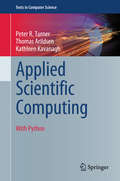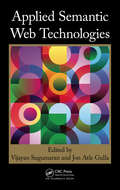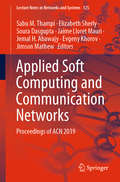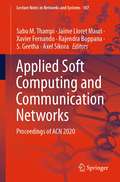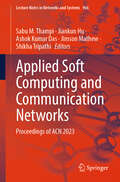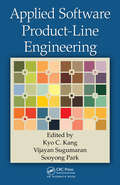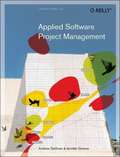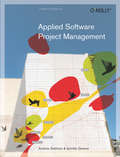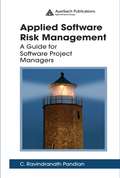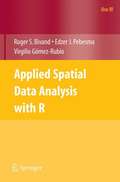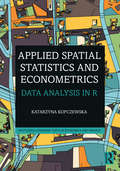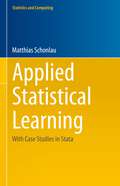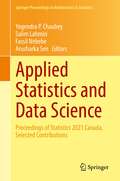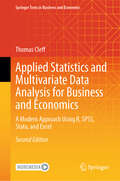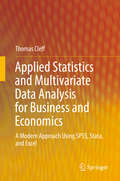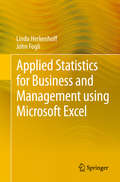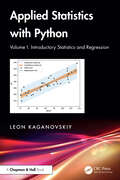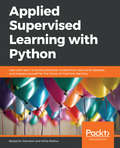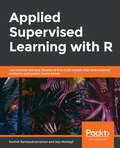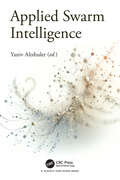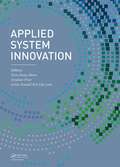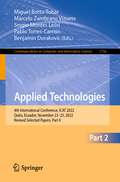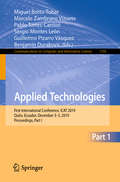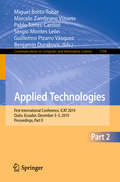- Table View
- List View
Applied Scientific Computing: With Python (Texts in Computer Science)
by Peter R. Turner Thomas Arildsen Kathleen KavanaghThis easy-to-understand textbook presents a modern approach to learning numerical methods (or scientific computing), with a unique focus on the modeling and applications of the mathematical content. Emphasis is placed on the need for, and methods of, scientific computing for a range of different types of problems, supplying the evidence and justification to motivate the reader. Practical guidance on coding the methods is also provided, through simple-to-follow examples using Python.Topics and features: provides an accessible and applications-oriented approach, supported by working Python code for many of the methods; encourages both problem- and project-based learning through extensive examples, exercises, and projects drawn from practical applications; introduces the main concepts in modeling, python programming, number representation, and errors; explains the essential details of numerical calculus, linear, and nonlinear equations, including the multivariable Newton method; discusses interpolation and the numerical solution of differential equations, covering polynomial interpolation, splines, and the Euler, Runge–Kutta, and shooting methods; presents largely self-contained chapters, arranged in a logical order suitable for an introductory course on scientific computing.Undergraduate students embarking on a first course on numerical methods or scientific computing will find this textbook to be an invaluable guide to the field, and to the application of these methods across such varied disciplines as computer science, engineering, mathematics, economics, the physical sciences, and social science.
Applied Semantic Web Technologies
by Vijayan Sugumaran Jon Atle GullaThe rapid advancement of semantic web technologies, along with the fact that they are at various levels of maturity, has left many practitioners confused about the current state of these technologies. Focusing on the most mature technologies, Applied Semantic Web Technologies integrates theory with case studies to illustrate the history, current st
Applied Soft Computing and Communication Networks: Proceedings of ACN 2019 (Lecture Notes in Networks and Systems #125)
by Jemal H. Abawajy Jimson Mathew Sabu M. Thampi Jaime Lloret Mauri Soura Dasgupta Elizabeth Sherly Evgeny KhorovThis book constitutes best selected research papers presented at the International Applied Soft Computing and Communication Networks (ACN 2019) held in Trivandrum, Kerala, India during December 18 – 21, 2019. The papers are organized in topical sections on real time and multimedia communications, security and privacy, network management and software-defined networks, Internet of Things (IoT) and cyber-physical systems, intelligent distributed systems, mobile computing and vehicle communications, surveillance networks and visual intelligence, and emerging topics. The book is a reference for researchers and scientists engaged in various fields of intelligent systems.
Applied Soft Computing and Communication Networks: Proceedings of ACN 2020 (Lecture Notes in Networks and Systems #187)
by Sabu M. Thampi Xavier Fernando Jaime Lloret Mauri Axel Sikora Rajendra Boppana S. GeethaThis book constitutes thoroughly refereed post-conference proceedings of the International Applied Soft Computing and Communication Networks (ACN 2020) held in VIT, Chennai, India, during October 14–17, 2020. The research papers presented were carefully reviewed and selected from several initial submissions. The book is directed to the researchers and scientists engaged in various fields of intelligent systems.
Applied Soft Computing and Communication Networks: Proceedings of ACN 2023 (Lecture Notes in Networks and Systems #966)
by Jimson Mathew Sabu M. Thampi Jiankun Hu Ashok Kumar Das Shikha TripathiThis book constitutes thoroughly refereed post-conference proceedings of the International Applied Soft Computing and Communication Networks (ACN 2023) held at PES University, Bangalore, India, during December 18–20, 2023. The research papers presented were carefully reviewed and selected from several initial submissions. The papers are organized in topical sections on security and privacy, network management and software-defined networks, Internet of Things (IoT) and cyber-physical systems, intelligent distributed systems, mobile computing and vehicle communications, and emerging topics. The book is directed to the researchers and scientists engaged in various fields of intelligent systems.
Applied Software Product Line Engineering
by Kang Vijayan Sugumaran Sooyong ParkOver the last decade, software product line engineering (SPLE) has emerged as one of the most promising software development paradigms for increasing productivity in IT-related industries. Detailing the various aspects of SPLE implementation in different domains, Applied Software Product Line Engineering documents best practices with regard to syst
Applied Software Project Management
by Jennifer Greene Andrew Stellman"If you're looking for solid, easy-to-follow advice on estimation, requirements gathering, managing change, and more, you can stop now: this is the book for you." --Scott Berkun, Author of The Art of Project Management What makes software projects succeed? It takes more than a good idea and a team of talented programmers. A project manager needs to know how to guide the team through the entire software project. There are common pitfalls that plague all software projects and rookie mistakes that are made repeatedly--sometimes by the same people! Avoiding these pitfalls is not hard, but it is not necessarily intuitive. Luckily, there are tried and true techniques that can help any project manager. In Applied Software Project Management , Andrew Stellman and Jennifer Greene provide you with tools, techniques, and practices that you can use on your own projects right away. This book supplies you with the information you need to diagnose your team's situation and presents practical advice to help you achieve your goal of building better software. Topics include: Planning a software project Helping a team estimate its workload Building a schedule Gathering software requirements and creating use cases Improving programming with refactoring, unit testing, and version control Managing an outsourced project Testing software Jennifer Greene and Andrew Stellman have been building software together since 1998. Andrew comes from a programming background and has managed teams of requirements analysts, designers, and developers. Jennifer has a testing background and has managed teams of architects, developers, and testers. She has led multiple large-scale outsourced projects. Between the two of them, they have managed every aspect of software development. They have worked in a wide range of industries, including finance, telecommunications, media, nonprofit, entertainment, natural-language processing, science, and academia. For more information about them and this book, visit http://www.stellman-greene.com .
Applied Software Project Management
by Jennifer Greene Andrew StellmanThis guide takes a practical approach to project management, describing specific tools, techniques and practices needed to run a successful project or to redirect a failing one. The topics covered include helping a team estimate its workload, building a schedule, gathering requirements and creating use cases, managing an outsourced project, and testing software. The text also offers tips about how to avoid common pitfalls. Annotation ©2006 Book News, Inc. , Portland, OR (booknews. com)
Applied Software Project Management
by Jennifer Greene Andrew Stellman"If you're looking for solid, easy-to-follow advice on estimation, requirements gathering, managing change, and more, you can stop now: this is the book for you."--Scott Berkun, Author of The Art of Project ManagementWhat makes software projects succeed? It takes more than a good idea and a team of talented programmers. A project manager needs to know how to guide the team through the entire software project. There are common pitfalls that plague all software projects and rookie mistakes that are made repeatedly--sometimes by the same people! Avoiding these pitfalls is not hard, but it is not necessarily intuitive. Luckily, there are tried and true techniques that can help any project manager.In Applied Software Project Management, Andrew Stellman and Jennifer Greene provide you with tools, techniques, and practices that you can use on your own projects right away. This book supplies you with the information you need to diagnose your team's situation and presents practical advice to help you achieve your goal of building better software.Topics include:Planning a software projectHelping a team estimate its workloadBuilding a scheduleGathering software requirements and creating use casesImproving programming with refactoring, unit testing, and version controlManaging an outsourced projectTesting softwareJennifer Greene and Andrew Stellman have been building software together since 1998. Andrew comes from a programming background and has managed teams of requirements analysts, designers, and developers. Jennifer has a testing background and has managed teams of architects, developers, and testers. She has led multiple large-scale outsourced projects. Between the two of them, they have managed every aspect of software development. They have worked in a wide range of industries, including finance, telecommunications, media, nonprofit, entertainment, natural-language processing, science, and academia. For more information about them and this book, visit stellman-greene.com
Applied Software Risk Management: A Guide for Software Project Managers
by C. Ravindranath PandianFew software projects are completed on time, on budget, and to their original specifications. Focusing on what practitioners need to know about risk in the pursuit of delivering software projects, Applied Software Risk Management: A Guide for Software Project Managers covers key components of the risk management process and the software development
Applied Spatial Data Analysis with R
by Roger Bivand Edzer J. Pebesma Virgilio Gómez-Rubio Roger S. BivandApplied Spatial Data Analysis with R is divided into two basic parts, the first presenting R packages, functions, classes and methods for handling spatial data. This part is of interest to users who need to access and visualise spatial data. Data import and export for many file formats for spatial data are covered in detail, as is the interface between R and the open source GRASS GIS. The second part showcases more specialised kinds of spatial data analysis, including spatial point pattern analysis, interpolation and geostatistics, areal data analysis and disease mapping. The coverage of methods of spatial data analysis ranges from standard techniques to new developments, and the examples used are largely taken from the spatial statistics literature. All the examples can be run using R contributed packages available from the CRAN website, with code and additional data sets from the book's own website. This book will be of interest to researchers who intend to use R to handle, visualise, and analyse spatial data. It will also be of interest to spatial data analysts who do not use R, but who are interested in practical aspects of implementing software for spatial data analysis. It is a suitable companion book for introductory spatial statistics courses and for applied methods courses in a wide range of subjects using spatial data, including human and physical geography, geographical information systems, the environmental sciences, ecology, public health and disease control, economics, public administration and political science.
Applied Spatial Statistics and Econometrics: Data Analysis in R (Routledge Advanced Texts in Economics and Finance)
by Katarzyna KopczewskaThis textbook is a comprehensive introduction to applied spatial data analysis using R. Each chapter walks the reader through a different method, explaining how to interpret the results and what conclusions can be drawn. The author team showcases key topics, including unsupervised learning, causal inference, spatial weight matrices, spatial econometrics, heterogeneity and bootstrapping. It is accompanied by a suite of data and R code on Github to help readers practise techniques via replication and exercises. This text will be a valuable resource for advanced students of econometrics, spatial planning and regional science. It will also be suitable for researchers and data scientists working with spatial data.
Applied Statistical Learning: With Case Studies in Stata (Statistics and Computing)
by Matthias SchonlauThis textbook provides an accessible overview of statistical learning methods and techniques, and includes case studies using the statistical software Stata. After introductory material on statistical learning concepts and practical aspects, each further chapter is devoted to a statistical learning algorithm or a group of related techniques. In particular, the book presents logistic regression, regularized linear models such as the Lasso, nearest neighbors, the Naive Bayes classifier, classification trees, random forests, boosting, support vector machines, feature engineering, neural networks, and stacking. It also explains how to construct n-gram variables from text data. Examples, conceptual exercises and exercises using software are featured throughout, together with case studies in Stata, mostly from the social sciences; true to the book’s goal to facilitate the use of modern methods of data science in the field. Although mainly intended for upper undergraduate and graduate students in the social sciences, given its applied nature, the book will equally appeal to readers from other disciplines, including the health sciences, statistics, engineering and computer science.
Applied Statistics and Data Science: Proceedings of Statistics 2021 Canada, Selected Contributions (Springer Proceedings in Mathematics & Statistics #375)
by Yogendra P. Chaubey Salim Lahmiri Fassil Nebebe Arusharka SenThis proceedings volume features top contributions in modern statistical methods from Statistics 2021 Canada, the 6th Annual Canadian Conference in Applied Statistics, held virtually on July 15-18, 2021. Papers are contributed from established and emerging scholars, covering cutting-edge and contemporary innovative techniques in statistics and data science. Major areas of contribution include Bayesian statistics; computational statistics; data science; semi-parametric regression; and stochastic methods in biology, crop science, ecology and engineering. It will be a valuable edited collection for graduate students, researchers, and practitioners in a wide array of applied statistical and data science methods.
Applied Statistics and Multivariate Data Analysis for Business and Economics: A Modern Approach Using R, SPSS, Stata, and Excel (Springer Texts in Business and Economics)
by Thomas CleffThis comprehensive textbook equips students of economics and business, as well as industry professionals, with essential principles, techniques, and applications of applied statistics, statistical testing, and multivariate data analysis. Through real-world business examples, it illustrates the practical use of univariate, bivariate, and multivariate statistical methods. The content spans a broad range of topics, from data collection and scaling to the presentation and fundamental univariate analysis of quantitative data, while also demonstrating advanced analytical techniques for exploring multivariate relationships. The book systematically covers all topics typically included in university-level courses on statistics and advanced applied data analysis. Beyond theoretical discussion, it offers hands-on guidance for using statistical software tools such as Excel, SPSS, Stata, and R. In this completely revised and updated second edition, new sections on logistic regression are included, along with enhanced examples and solutions using R for all covered statistical methods. This edition provides a robust resource for mastering applied statistics in both academic and professional settings.
Applied Statistics and Multivariate Data Analysis for Business and Economics: A Modern Approach Using SPSS, Stata, and Excel
by Thomas CleffThis textbook will familiarize students in economics and business, as well as practitioners, with the basic principles, techniques, and applications of applied statistics, statistical testing, and multivariate data analysis. Drawing on practical examples from the business world, it demonstrates the methods of univariate, bivariate, and multivariate statistical analysis. The textbook covers a range of topics, from data collection and scaling to the presentation and simple univariate analysis of quantitative data, while also providing advanced analytical procedures for assessing multivariate relationships. Accordingly, it addresses all topics typically covered in university courses on statistics and advanced applied data analysis. In addition, it does not limit itself to presenting applied methods, but also discusses the related use of Excel, SPSS, and Stata.
Applied Statistics for Business and Management using Microsoft Excel
by Linda Herkenhoff John FogliApplied Business Statistics for Business and Management using Microsoft Excel is the first book to illustrate the capabilities of Microsoft Excel to teach applied statistics effectively. It is a step-by-step exercise-driven guide for students and practitioners who need to master Excel to solve practical statistical problems in industry. If understanding statistics isn't your strongest suit, you are not especially mathematically-inclined, or if you are wary of computers, this is the right book for you. Excel, a widely available computer program for students and managers, is also an effective teaching and learning tool for quantitative analyses in statistics courses. Its powerful computational ability and graphical functions make learning statistics much easier than in years past. However, Applied Business Statistics for Business and Management capitalizes on these improvements by teaching students and practitioners how to apply Excel to statistical techniques necessary in their courses and workplace. Each chapter explains statistical formulas and directs the reader to use Excel commands to solve specific, easy-to-understand business problems. Practice problems are provided at the end of each chapter with their solutions.
Applied Statistics with Python: Volume I: Introductory Statistics and Regression
by Leon KaganovskiyApplied Statistics with Python: Volume I: Introductory Statistics and Regression concentrates on applied and computational aspects of statistics, focusing on conceptual understanding and Python-based calculations. Based on years of experience teaching introductory and intermediate Statistics courses at Touro University and Brooklyn College, this book compiles multiple aspects of applied statistics, teaching the reader useful skills in statistics and computational science with a focus on conceptual understanding. This book does not require previous experience with statistics and Python, explaining the basic concepts before developing them into more advanced methods from scratch. Applied Statistics with Python is intended for undergraduate students in business, economics, biology, social sciences, and natural science, while also being useful as a supplementary text for more advanced students.Key Features: Concentrates on more introductory topics such as descriptive statistics, probability, probability distributions, proportion and means hypothesis testing, as well as one-variable regression The book’s computational (Python) approach allows us to study Statistics much more effectively. It removes the tedium of hand/calculator computations and enables one to study more advanced topics Standardized sklearn Python package gives efficient access to machine learning topics Randomized homework as well as exams are provided in the author’s course shell on My Open Math web portal (free)
Applied Supervised Learning with Python: Use scikit-learn to build predictive models from real-world datasets and prepare yourself for the future of machine learning
by Benjamin Johnston Ishita MathurExplore the exciting world of machine learning with the fastest growing technology in the worldKey FeaturesUnderstand various machine learning concepts with real-world examplesImplement a supervised machine learning pipeline from data ingestion to validationGain insights into how you can use machine learning in everyday lifeBook DescriptionMachine learning—the ability of a machine to give right answers based on input data—has revolutionized the way we do business. Applied Supervised Learning with Python provides a rich understanding of how you can apply machine learning techniques in your data science projects using Python. You'll explore Jupyter Notebooks, the technology used commonly in academic and commercial circles with in-line code running support.With the help of fun examples, you'll gain experience working on the Python machine learning toolkit—from performing basic data cleaning and processing to working with a range of regression and classification algorithms. Once you’ve grasped the basics, you'll learn how to build and train your own models using advanced techniques such as decision trees, ensemble modeling, validation, and error metrics. You'll also learn data visualization techniques using powerful Python libraries such as Matplotlib and Seaborn. This book also covers ensemble modeling and random forest classifiers along with other methods for combining results from multiple models, and concludes by delving into cross-validation to test your algorithm and check how well the model works on unseen data.By the end of this book, you'll be equipped to not only work with machine learning algorithms, but also be able to create some of your own!What you will learnUnderstand the concept of supervised learning and its applicationsImplement common supervised learning algorithms using machine learning Python librariesValidate models using the k-fold techniqueBuild your models with decision trees to get results effortlesslyUse ensemble modeling techniques to improve the performance of your modelApply a variety of metrics to compare machine learning modelsWho this book is forApplied Supervised Learning with Python is for you if you want to gain a solid understanding of machine learning using Python. It'll help if you to have some experience in any functional or object-oriented language and a basic understanding of Python libraries and expressions, such as arrays and dictionaries.
Applied Supervised Learning with R: Use machine learning libraries of R to build models that solve business problems and predict future trends
by Jojo Moolayil Karthik RamasubramanianExplore supervised machine learning with R by studying popular real-world uses cases such as object detection in driverless cars, customer churn, and default predictionKey FeaturesStudy supervised learning algorithms by using real-world datasets Fine tune optimal parameters with hyperparameter optimizationSelect the best algorithm using the model evaluation frameworkBook DescriptionR provides excellent visualization features that are essential for exploring data before using it in automated learning. Applied Supervised Learning with R helps you cover the complete process of employing R to develop applications using supervised machine learning algorithms for your business needs. The book starts by helping you develop your analytical thinking to create a problem statement using business inputs and domain research. You will then learn different evaluation metrics that compare various algorithms, and later progress to using these metrics to select the best algorithm for your problem. After finalizing the algorithm you want to use, you will study the hyperparameter optimization technique to fine-tune your set of optimal parameters. To prevent you from overfitting your model, a dedicated section will even demonstrate how you can add various regularization terms.By the end of this book, you will have the advanced skills you need for modeling a supervised machine learning algorithm that precisely fulfills your business needs.What you will learnDevelop analytical thinking to precisely identify a business problemWrangle data with dplyr, tidyr, and reshape2Visualize data with ggplot2Validate your supervised machine learning model using k-fold Optimize hyperparameters with grid and random search, and Bayesian optimizationDeploy your model on Amazon Web Services (AWS) Lambda with plumberImprove your model’s performance with feature selection and dimensionality reductionWho this book is forThis book is specially designed for novice and intermediate-level data analysts, data scientists, and data engineers who want to explore different methods of supervised machine learning and its various use cases. Some background in statistics, probability, calculus, linear algebra, and programming will help you thoroughly understand and follow the content of this book.
Applied Swarm Intelligence
by Yaniv AltshulerThis book provides a comprehensive analysis of the tools and techniques used today for designing and modeling of efficient and robust swarm-intelligence based systems: highly (or fully) decentralized, semi-autonomous, highly-scalable infrastructures in various real-life scenarios. Among others, the book reviews the use of the swarm intelligence paradigm in financial investment, blockchain protocols design, shared transportation systems, communication networks, bioinformatics, and military applications. Theoretical and practical limitations of such systems, as well as trade-offs between the various economic and operational parameters of the systems, are discussed. The book is intended for researchers and engineers in the fields of swarm systems, economics, agriculture, nutrition, and operation research.
Applied System Innovation: Proceedings of the 2015 International Conference on Applied System Innovation (ICASI 2015), May 22-27, 2015, Osaka, Japan
by Teen-Hang Meen Stephen Prior Artde Donald LamThe 2015 International Conference on Applied System Innovation (ICASI 2015) was held May 22-27, 2015 in Osaka, Japan and provided a unified communication platform for researchers active in a wide range of research fields. Professionals from industry, academia and government were encouraged to discourse on research and development, professional practice, business and management in the information, innovation, communication and engineering fields. This conference enabled interdisciplinary collaboration between science and engineering technologists in the academic and industry fields as well as networking internationally. The conference received 1063 submitted papers, whereby 421 papers were selected by the committees to be presented at the ICASI 2015 conference. These papers were divided into 13 Regular Sessions and 13 Invited Sessions, and presented in several parallel sessions. The ICASI 2015 committees selected 226 excellent papers for publication in this proceedings volume, covering topics ranging from information technology, innovation design, communication science and engineering, industrial design, creative design, applied mathematics, computer science, design theory and cultural and creative research to electrical and electronic engineering, mechanical and automation engineering, green technology and architecture engineering and material science, among others.
Applied Technologies: 4th International Conference, ICAT 2022, Quito, Ecuador, November 23–25, 2022, Revised Selected Papers, Part II (Communications in Computer and Information Science #1756)
by Miguel Botto-Tobar Marcelo Zambrano Vizuete Pablo Torres-Carrión Sergio Montes León Benjamin DurakovicThis three-volume set CCIS 1755-1757 constitutes the refereed proceedings of the 4th International Conference on Applied Technologies, ICAT 2022, held in Quito, Ecuador, in November 2022. The 112 full papers included in this book were carefully reviewed and selected from 415 submissions. They were organized in topical sections as follows: human computing and information science, IT financial and business management.
Applied Technologies: First International Conference, ICAT 2019, Quito, Ecuador, December 3–5, 2019, Proceedings, Part I (Communications in Computer and Information Science #1193)
by Miguel Botto-Tobar Marcelo Zambrano Vizuete Pablo Torres-Carrión Sergio Montes León Guillermo Pizarro Vásquez Benjamin DurakovicThis first volume of the three-volume set (CCIS 1193, CCIS 1194, and CCIS 1195) constitutes the refereed proceedings of the First International Conference on Applied Technologies, ICAT 2019, held in Quito, Ecuador, in December 2019. The 124 full papers were carefully reviewed and selected from 328 submissions. The papers are organized according to the following topics: technology trends; computing; intelligent systems; machine vision; security; communication; electronics; e-learning; e-government; e-participation.
Applied Technologies: First International Conference, ICAT 2019, Quito, Ecuador, December 3–5, 2019, Proceedings, Part II (Communications in Computer and Information Science #1194)
by Miguel Botto-Tobar Marcelo Zambrano Vizuete Pablo Torres-Carrión Sergio Montes León Guillermo Pizarro Vásquez Benjamin DurakovicThis second volume of the three-volume set (CCIS 1193, CCIS 1194, and CCIS 1195) constitutes the refereed proceedings of the First International Conference on Applied Technologies, ICAT 2019, held in Quito, Ecuador, in December 2019. The 124 full papers were carefully reviewed and selected from 328 submissions. The papers are organized according to the following topics: technology trends; computing; intelligent systems; machine vision; security; communication; electronics; e-learning; e-government; e-participation.
